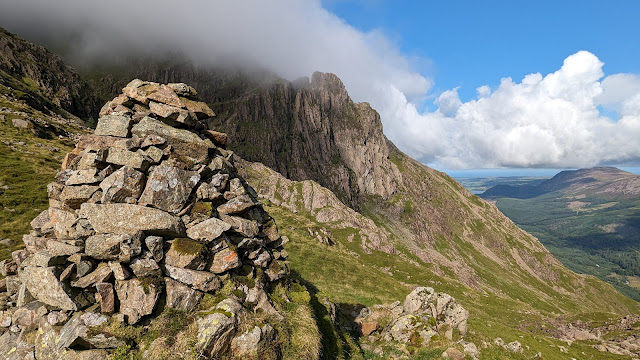Great Borne and Starling Dodd
TWO Wainwright circular walk: Great Borne, Starling Dodd.
Walk Rating:⭐⭐⭐⭐
Time: 4 hours
Parking: Bowness Knott Car Park, Ennerdale (free)
 |
| Great Borne and Starling Dodd from Crag Fell |
Ennerdale Water is not the most visited corner of the Lake District, and the two fells that rise to its north, Great Borne and Starling Dodd, are not some of its most frequently walked peaks. However, it's definitely worth driving out to the Forestry England car park at Bowness Knott for this circular walk.
These are much more than just two peaks to climb if you're trying to "walk the Wainwrights". This hike features an excellent ascent, a good view from a cairn of mangled fenceposts, and some interesting old stone structures too!
 |
| Looking back to Crag Fell from the start of the path |
2. Our path heads upwards, with the wooded hillock of Bowness Knott to our right (which can be accessed by another path that bears off towards it). Keep following our path upwards, with the beck on your left, and another small rise, named 'Brown How' on the OS map, to your right. You are heading for the gully in the ridge above that has been carved out by the beck as it flows down from the top of Great Borne.
 |
| You are heading to the gully at the top right |
3. You will be on the right path if you reach a 'doughnut' of circular walls, marked in the Wainwright Walking Guide to the Western Fells as a 'fox trap'. This is one of only around eight examples of these old structures left in the Lake District. They were apparently designed so that a fox, falling into its centre, would be unable to escape.
 |
| The path climbs up beyond the 'fox trap' |
4. The path ascends at the side of the beck as it enters the steeper gully section. There isn't really any major difficulty though and the path is much easier than it might look from below. There are excellent views back down to Ennerdale.
 |
| Looking back down from the gully |
5. Once out of the gully, the scenery opens out to the moorland at the top of the fell and a path goes up more gently to the surprisingly rocky summit of Great Borne. You'll find a stone shelter and a OS triangulation column amongst the boulders.
 |
| The summit plateau of Great Borne |
6. A sturdy fence runs right across the top of Great Borne. Left, to the north-west, the fence goes down to the path descending Steel Brow to the Floutern Pass. Right, to the south-east, it leads on to Starling Dodd. Before heading that way, it's worth scaling the fence and across the boulders on the northern part of the summit to look down at Floutern Tarn and the Loweswater Fells below.
7. It's easy to follow the path along the fence line towards the rounded peak of Starling Dodd in the distance. At an angle in the fence, head straight on towards the hilltop in front of you. It will only take 30 minutes or so to go from one fell to the other.
 |
| The path heads up from the angle above |
8. There's a surprising addition to the small stone cairn at the top of Starling Dodd - a metal 'cairn' of rusty iron fenceposts! If the weather allows, take a rest on the grassy slopes and take in the views before moving on.
9. It would be possible to continue the hike along the ridge to Red Pike above Buttermere and to make a longer circuit down into the higher reaches of the Ennerdale Forest. But my suggestion for making your way back into Ennerdale is to now turn back towards the depression between today's two peaks, then make your way down the slope into Ennerdale.
 |
| Make your way left down the slope to Ennerdale |
10. Now and again there are vague traces of what might be paths as you descend towards the forest but you really just need to make your own way downhill through the hummocky grass and bracken. Keep the more defined valley of 'Clewes Gill' away to your right, and aim for a gate that you will start to see at the edge of the trees, at a point where the fence line is indented slightly into the forested area below. Shortly before the gate, you may come across a remote 'rain gauge' hidden in the bracken.
 |
| Heading back along the lakeside to Bowness Knott |
Worth knowing: When you're wandering back through the trees around Smithy Beck, take a careful look if you come across some ruined foundations - but certainly do not disturb the stones, as these are scheduled historic monuments. They are thought to be remaining traces of mediaeval 'double-walled' longhouses, possibly linked to early iron mining activities in the area of Clewes Gill.
Ennerdale itself may be a name derived from the Old Norse Anundar-dalr, meaning ‘Anund’s valley’. Great Borne appears to be referred to as 'Hardecnut' in the thirteenth century, from the Old Norse knott or late Old English cnotta, ‘a rocky hill or summit’. Further up Ennerdale, the Youth Hostel at High Gillerthwaite probably takes its name from the Norse 'Gil', a ravine or narrow valley, and 'Thveit', a clearing.










